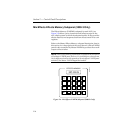
2-20
Section 2 — Control Panel Descriptions
Transition Controls
You can perform a transition using any of three different controls:
the lever arm, the AUTO TRAN button, or the CUT button.
The lever arm is used to perform “manual” transitions. The BKGD
B
, BKGD A, KEY 1, KEY 2, KEY PRIOR buttons, or any combination
thereof, can be delegated to the lever arm to perform the transition.
You can move the lever arm in either direction due to the flip-flop
architecture of the buses. Moving the lever arm from one limit to
the other always performs a complete transition.
Using the lever arm, it is possible to start a transition, stop it at
any point, reverse it, and even return to the original limit,
without completing the transition. The green arrow at the top
or bottom of the
lever arm travel lights to indicate the direction
that the lever arm has to move to complete the transition.
You can use the lever arm in combination with the AUTO TRAN
button to perform a transition. You can start the transition by
moving the lever arm off its limit, and finish the transition by
pressing AUTO TRAN. The transition is completed at a rate
proportional to the rate set for a full AUTO TRAN transition. For
example, if the lever arm is moved halfway and the transition is
completed by pressing AUTO TRAN at a rate of 200 frames, the
remaining half of the transition will take 100 frames.
NOTE:
The lever arm will be left off-limit any time you begin a
transition with the lever arm and finish it with AUTO TRAN. The lever
arm
will not function properly again until is moved to either limit (this
action will not change the M/E output). While the lever arm is non-
functional, both lever arm direction indicators are on.
Pressing CUT cannot, however, complete a transition begun with
the lever arm. In this case, CUT reverses the inputs during the
background transitions. During key transitions, it changes the
logic state of the key.
AUTO
TRAN
CUT


















